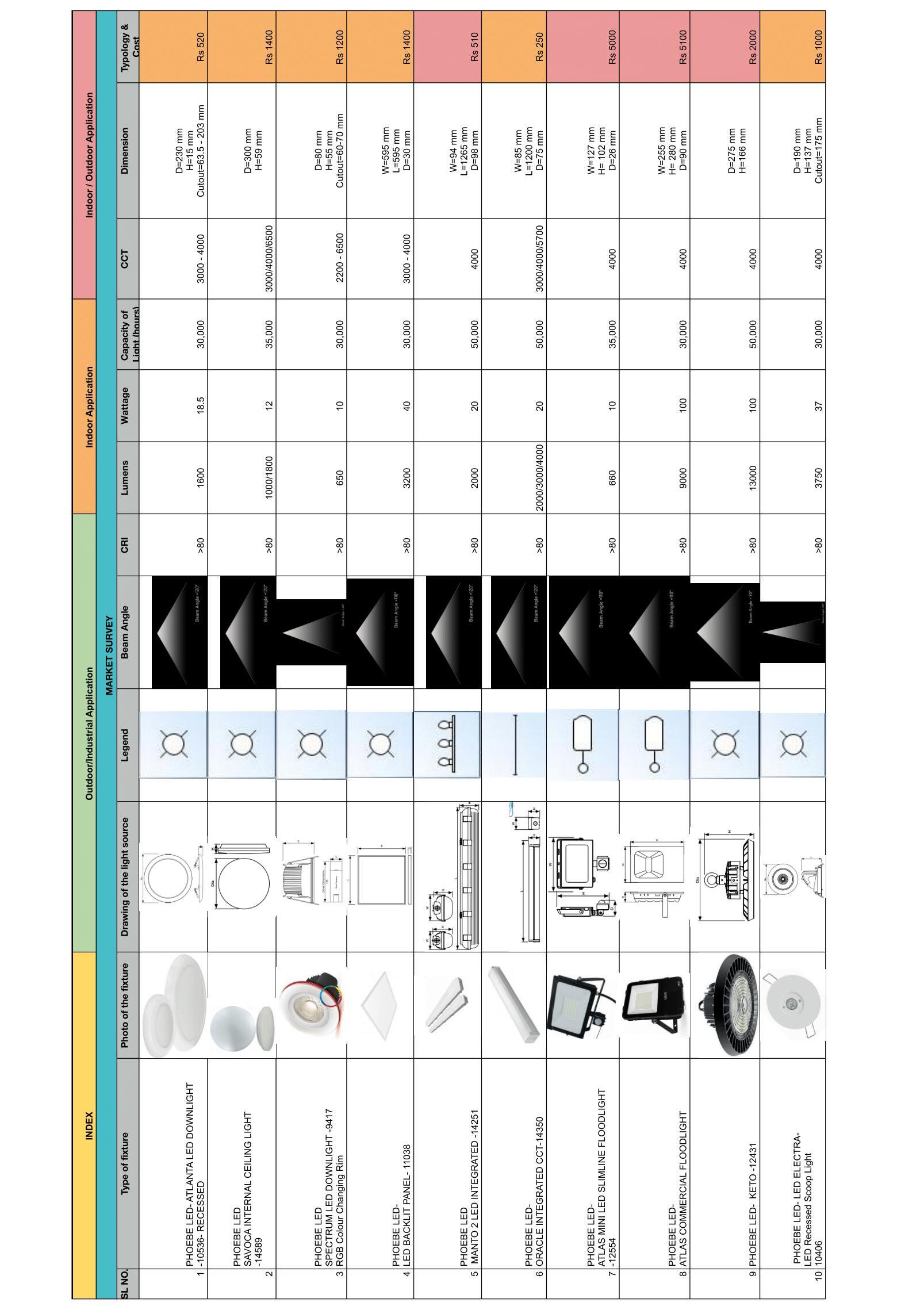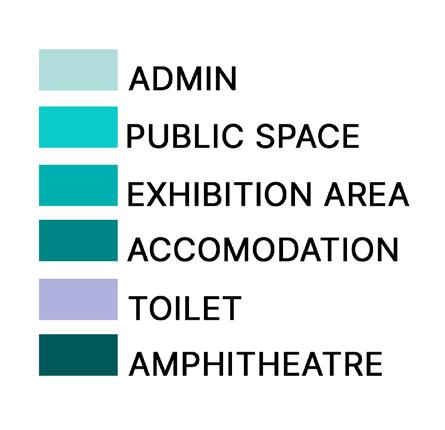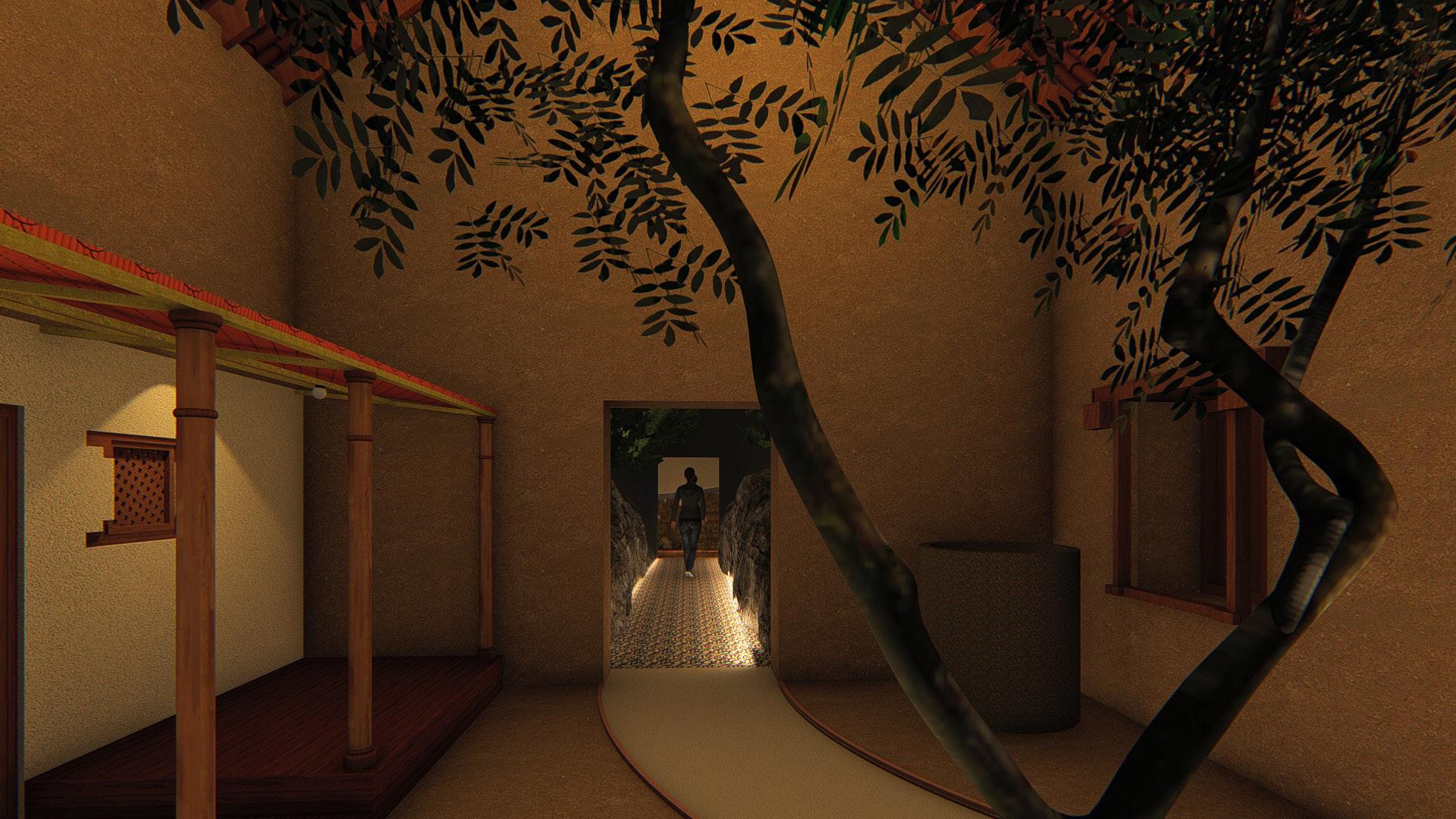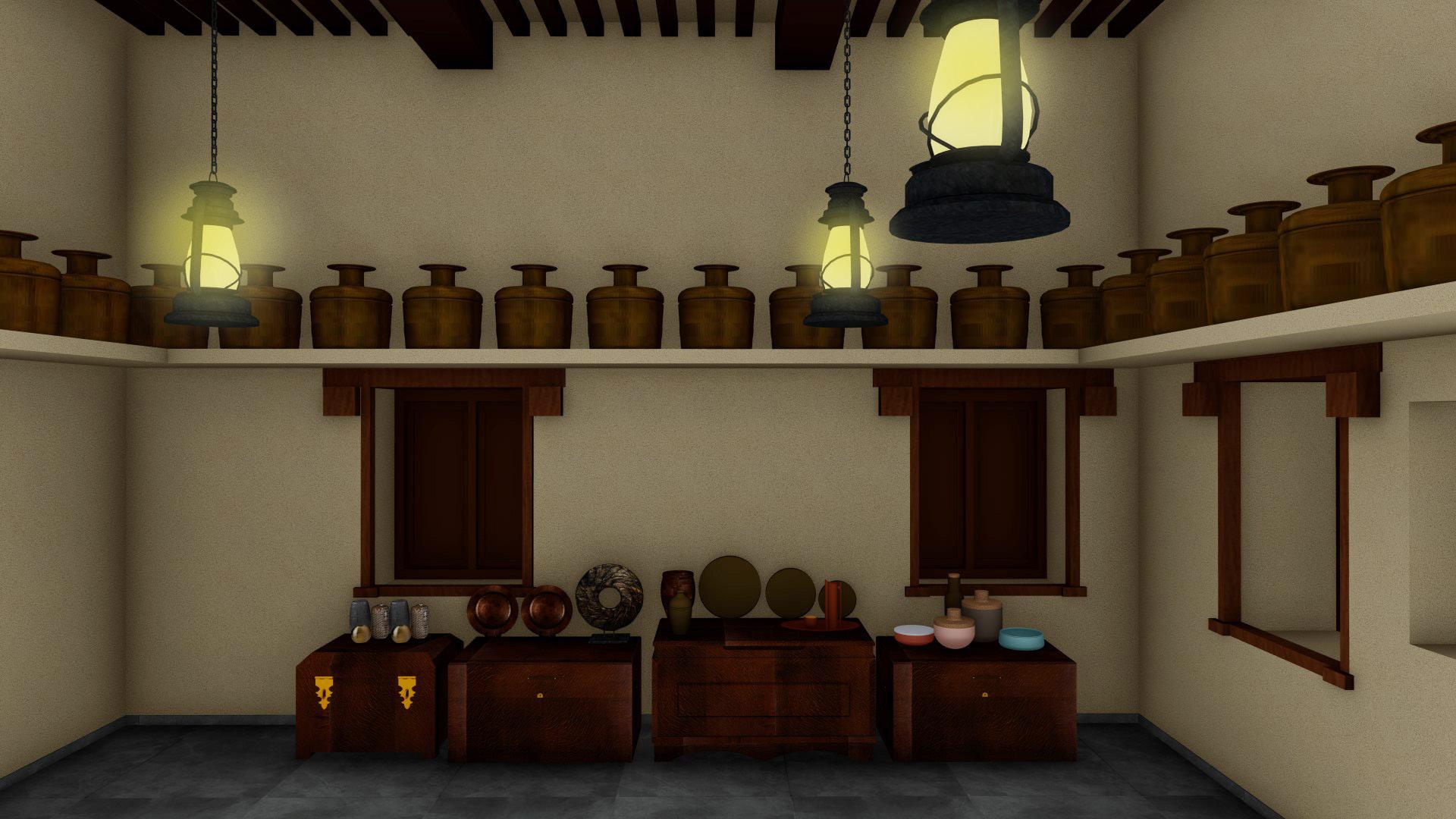
Student
Faculty of Architecture
CEPT University
Shailee Trivedi & Vaibhavi Thakkar Desai
Teaching Associate Reeya Detroja Tutor and Co-Tutor
of Light
Poetry
Spring 2024 | L4 | MID | ID4032
Code & Name PID22113 Fadaya
3.1.
3.2.
3.3.
3.4
3.5
2 Contents
About the Studio
Introducing Light
Dialogue through Light
Movie Clippings
Role of Light through Case Studies
Market Survey of Lighting Fixtures 02 Light Analysis and Synthesis
Report Writing
Play
Light 03
Project
00
01
1.1
1.2
1.3
1.4
2.1
2.3
of
Design
Project Brief cand Concept
Site Plan
Space Planning and Orgazation
Lighting Strategies and Experiences
Lighting Estimation
00 About the Studio
3
Stages of the Studio: Explore Analyse
Synthesise
Phase 1
Lighting explortion, Lighting study through case studies and Market Survey
Phase 2
Study of Light and it’s effects and affects
Phase 3
Relation of Light with spaces and environment
Phase 4
Lighting design development with Lighting Estimation
About the Studio:
Studio incorporates Fundamentals of Daylight, daylight controls, shading systems for heat and Glare Management, daylight quality and distribution. Intentions are to make students understand the importance of daylighting and the techniques of incorporating and balancing it. The study exercise of building a model and playing with light shall be given which at the end becomes an extensive study model to understand daylight and its relations with interior space. It also incorporates biodynamic lighting and lighting effects in human wellbeing, Artificial Lighting with study of basic design guidelines and design criteria. It also includes two Interior lighting design projects where students complete the final project with specification of luminaires and tendering.
At the end of the studio, students learn the basic fundamentals of lighting design with three projects in the term, to help them understand and respect light in a better way
4
Learning Outcomes:
After completing the Studio,the student will be able to Students will be able to
Evaluate and design Daylighting, Artificial Lighting and Lighting Applications.
Evaluate the quality of daylight in indoor spaces, additionally also understand relationship between daylight and artificial light considering effects on energy use and design.
Also understand relevant thermodynamic properties of buildings with the possibilities for the integration of lighting into building control systems.
Understand the impact of lighting on climate, culture and design accordingly. Students will learn to propose tenders for their designed spaces.
What Problem is the Studio solving?
Human Needs
Visibility
Visual Comfort Health
Safety Welfare
Aesthetic Judgement
Social Relations
Ergonimics & Environment
Installation
Operation & Maintenence
5
Energy Consumption
Composition Style Standards
Architecture Shape
Recommendation Quality Lighting
6
7 01
Introducing Light
Brief & Intent:
This exercise aims to initiate students into the poetic and communicative language of light. Video is shared with students, to which they are encouraged to express their understanding of light in an imaginative and abstract manner. Through doodling, sketches, and written expression, students embark on a journey to articulate their personal dialogue with light, fostering a deeper connection and appreciation for its nuances.
Learning Outcomes:
• Cultivate a poetic sensibility
• Expressive communication
• Critical observation
• Conceptual understanding
1.1 Dialogue through Light
8






In the quiet glow, hidden truths emerge, light stretches through the dark. Seeking brightness leads on a journey where space and shapes intertwine, forming a story told by the universe.
 By Fadaya
By Fadaya
9
Dialogue through Light
1.2 Movie Clippings
Brief & Intent:
This exercise seeks to expand students’ understanding of light by exploring its role in cinematic storytelling. By selecting specific words from Exercise 1, students are tasked with identifying and analyzing how light is choreographed in movie scenes to evoke mood, convey narrative themes, and manipulate audience perception.
Learning Outcomes:
•Through this exploration, students learn to apply principles of lighting design in a narrative context, enhancing their ability to orchestrate light to create compelling spatial experiences.
•How lighting can transform spatial experiences, influencing human perception and interaction with architectural environments.
10


















11 30:07 30:07 30:07 30:07 30:07 30:07 30:07 30:07 30:07 30:07 30:07 30:07 30:07 30:07 30:07 30:07 30:07 30:07 Curiosity
Total Duration of the clip: 22 Sec Identity From Batman v Superman Total Duration of the clip: 17 Sec Focus From Catch Me If You Can Total Duration of the clip: 15 Sec Words derived from exercise 1.1
From Insidious: The Last
1.3 Role of Light through Case Studies
12
Brief & Intent
To build an understanding about artificial light and daylight and how it has evolved over the time in the interiors. They explored ideas and concepts that revolved around lighting by examining the projects through the lens of various parameters.
Students studied 20 projects
They looked at the following aspects:
• Conceptual detail about light
• Project Typology
• Scale of the Project
• Light details
• Product Specification (can be shading devices too)
• Role of Lighting
**The projects were from different timelines.
Learning Outcomes:
• Familiarizing with natural & artificial light in interior design projects.
13


Apartment Spectral
Location
Lighting Concept:
Mood lighting

Case Study 1
Chettinad Health City
Auditorium
Location
Lighting Concept:
lighting to enhance form
Case Study 2

Alembic Real Estate and Paushak Workspace
Vadodara
Lighting Concept
Light as a spatial definition
Case Study 3



Rajesh Pratap Singh Flagship
Store Pune
Lighting Concept
Subtle lighting
Case Study 4



Gong modern Asian restaurant
Pune
Lighting Concept
Light as an art
Case Study 5

Menil Collection
Houston, Texas
Lighting Concept
Diffused Light
Case Study 7
Haydar Aliyev Centre
Baku, Azerbaijan
Lighting Concept
lighting to enhance form
Case Study 6

Stockholm Odenplan
Stockholm, Sweden
Lighting Concept
Light as an art and wayfinder
Case Study 8
UK Pavilion
Dubai
Lighting Concept
Lighting as illusion
Case Study 9
Tate Modern Museum
London
Lighting Concept
Space defining element
Case Study 10
Apple Fifth Avenue
New York City
Lighting Concept:
Light as a deceiving factor
Case Study 11
Church of Light
Osaka, Japan
Lighting Concept
Spiritual Experience
Case Study 12
14

Sangath
Ahmedabad, Gujarat
Lighting Concept: Diffused lighting
Case Study 19

Agra, Uttar Pradesh
Lighting Concept: Lighting as an ornament

Jewish Museum Berlin
Berlin, Germany
Lighting Concept Conveying emotion
Case Study 13

Menil Collection
Houston, Texas
Lighting Concept: Diffused Light
Case Study 14

The Exeter’s Library
New Hampshire
Lighting Concept: Light as a directinal element
Case Study 15


IIM
Ahmedabad
Lighting Concept: Light as an identity
Case Study 16
Matrimandir
Pondicherry
Lighting Concept
Spritual
Case Study 17

Premabhai Hall Ahmedabad
Lighting Concept Light as a design tool
Case Study 18
15
Case Study 20
1.3 Role of Light through Case Studies
Taj Mahal
Brief & Intent:
Do a market survey to understand and familiarize yourself with the lighting vocabulary describing the lighting / lighting systems. Understand the properties such as type of lamp, beam angle, temperature, CRI, Lumens, Wattage, Capacity, Typology (Industrial / Commercial / Residential / Other).
Learning Outcomes:
The students developed the ability of investigating, inquiring the elements and format the information.
The students understood the vocabulary which became the base for them to utilize it appropriately in the upcoming exercises and the final project.
1.4 Market Survey of Lighting Fixtures
16
Brands


17

Crompton
By Fadaya
Summary:
Crompton’s LED and traditional lighting products cater to energy efficiency and longevity, suitable for residential and commercial spaces. Their outdoor and smart lighting options enhance security and convenience, with a capacity ranging from 10,000 to 40,000 hours and prices from Rs. 250 to Rs. 6,000. The colour temperature (CCT) spans from warm to cool tones (2700-6500K), with a Colour Rendering Index (CRI) exceeding 80.
18

19 1.4 Market Survey of Lighting Fixtures
02 Light Analysis and Synthesis

2.1 Report Writing
Brief & Intent
Adalaj Ni Vav studied as primary case for understanding of lighting design factors considering the influences of daylight and artificial light.
Topics to cover:
• Daylight quality & distribution in indoor spaces
• Sun-path & Sun angles
• Orientation
• Axis
• Geometry
• Volumetric analysis
• Layering in the spaces w.r.t .lighting
• Materiality
• Sciography
• Depth perception
Learning Outcomes:
• Ability to evaluate the quality of daylight in indoor spaces.
• Ability to evaluate the light quality through materials.
• Also understand daylight considering effects on energy use and design.
• Understand the way daylight is behaving w.r.t to different interior architectural elements in the space.
21

Daylight influence on Ornamental Depth and Spatial Dynamics within Jarokhas in Adalaj stepwell
Aim :Examining the daylight influence in Jarokhas in Adalaj stepwell
Scope:
This study examines how daylight influences the ornamental depth and spatial dynamics of Jarokhas in Adalaj Stepwell, elucidating their interaction with architectural features and natural lighting conditions.
Abstract :
Light within the Jarokhas of Adalaj Ni Vav defines the space, creating a nuanced atmosphere and storytelling through its dynamic effects, serving as transitional spaces that engage visitors in a dialogue with light and offer pause points for capturing memories.
22
Observations on Site
Research Methodology:
On January 26, 2024, a visit to Adalaj Ni Vav involved a detailed study of daylight’s influence on space and ornamentation, specifically focusing on the Jarokha element. Hourly photographs were taken to track the evolving effects of daylight changes, followed by a literature study to draw insights and conduct a thorough analysis based on observations.
Observation:
The significance of daylight in shaping spatial depth and ornamentation, emphasizing the importance of strategic surface modulation and orientation to optimize light penetration and diffusion. It underscores the dynamic interplay of light and darkness, showcasing how thoughtful planning of openings and contextual volumes can enhance spatial experiences while maintaining a consistent aesthetic.
Analysis:
The analysis of daylight influence on the Jarokha at various time frames reveals dynamic changes in light diffusion and spatial depth, with strategic openings facilitating dynamic spatial experiences. Despite facing different orientations, each Jarokha receives varying light intensities, emphasizing the interplay between light and darkness to enhance spatial dynamics and ornamentation.






Sunpath at 4

Sunpath at 10

Sunpath at 12


Observations on Site
23 2.1 Report Writing
Brief & Intent
Create criterias that are developed considering the daylight, and create a 3D model to understand the light behaviour.
The main shell of the model can be made using any material and in any form. It should contain in 1ft x 1ft x 1ft.
Study should incorporate:
• A model/ box of any size with apertures where you have the possibility to use light source from outside as well as inside and play happens with light and shadows.
• There should be possibilities to explore with internal surfaces and light sources too.
• Unconventional materials in combination
• Play with apertures, light sources, filters and internal surfaces
Learning Outcomes:
Ability to understand how light affects and effects the interior spaces and its interaction with different materials.
Ability to create and understand sciography in space. 2.2 Play Of Light
24

25

“Filter effects at different angles on light and reflective surfaces, documented by front-facing camera.”
Filtered Effects
Exploring light dispersion through filters and angles in a flexible form, using MS sheet, acrylic, and wire mesh. Analyzing spatial changes and effects for design optimization.
26
Overall Concept
Light dispersion, demonstrated by a prism’s separation of colors, extends beyond prisms to other mediums, altering light quality and behavior through diffusion, dispersion, or shadow casting.
Concept for lighting study
Direct light entering through slits at different angles interacts with filters, diffusing variably depending on screen properties and altering reflective surface effects, with light intensity shifting according to the angle of the light source.
Concept for form
Lighting intentions encompass goals and constraints guiding designers to achieve desired illumination, classified by factors including lighting representation, considered surfaces, target goals, and light transport levels, as detailed by Fernández (2015).
Parameters for form and lighting study
The study examines how light interacts with surfaces at fixed angles (45, 60, and 90 degrees) under various conditions (no filter, colored acrylic sheet, wired mesh), maintaining spatial symmetry to observe changes in spatial quality, focusing on lightinduced effects such as diffusion, dispersion, and shadow casting.
Materials - what and why?
MS sheet chosen for stability and low light emission; two filters, acrylic sheet for diffusion and wire mesh for shadow casting, selected for distinct experimental purposes.
Method of Analysis
A study compares filter effects at different angles on a constant light source, analyzing reflective surface changes and spatial quality with front-facing camera documentation.



27
Different effects at 90 °
At 90° without filters
At 60 °with acrylic
28
29
03 Final Project
3.1 Program Briefs and concepts

Questlight
Interpretation Centre
Program Brief:
The Swaminarayan Interpretation Center is a journey through the life stages and teachings of Swaminarayan, illuminated by light. Each space represents a significant phase of his life and ideology, offering visitors a deep understanding of his transformative journey and spiritual principles.
30

Concept:
The Swaminarayan Interpretation Center utilizes light as both ambiance creator and a navigational guide, defining each space to reflect a distinct stage in Swaminarayan’s life and teachings. As visitors progress, the lighting transitions to depict his journey from birth through spiritual enlightenment, effectively mapping his ideological evolution.
31
3.3 Space Planning and Organization
Zoning in Isometric view:


32
Circulation in Isometric view:

Circulation for Visitors

Circulation for Staffs

Circulation for Accommodation
33


34 Furniture
Layout:
Ground Floor Furniture Layout
First Floor Furniture Layout
3.4 Lighting Strategies and Experiences
Ghanshyam Hall :

Lighting Strategy

35
Drawings showing Lighting layout

Lighting Strategy

36
Nilkanth Varni Hall :
Drawings showing Lighting layout
Sculptural Hall :

Lighting Strategy

37
Drawings showing Lighting layout
Samapradaya Hall :

Lighting Strategy

38
Drawings showing Lighting layout

Lighting Strategy

39
Wisdom Hall :
Drawings showing Lighting layout
Columanted Hall :


40
Lighting Strategy
Drawings showing Lighting layout
Hall of Hope :


41
Lighting Strategy
Drawings showing Lighting layout
Hall of Thoughts :

Lighting Strategy
Hall of Worship:

Lighting Strategy
42

43
Drawings showing Lighting layout for Hall of thoughts and Hall of Worship
Swaminarayan Hall :


44
Lighting Strategy
Drawings showing Lighting layout
Rendered Views :



45
Ghanshyam Hall
Ghanshyam Hall
Nilkanth Varni Hall



46
Sculptural Hall
Sculptural Hall
Views :
Sculptural Hall
Rendered



47
Samapradaya Hall
Wisdom Hall
Columnated Hall
Rendered Views :



48
Hall of Hope
Hall of Thoughts
Rendered Views :
Hall of Worship



49
Swaminarayan Hall
Swaminarayan Hall
Swaminarayan Hall
Rendered Views :


50







 By Fadaya
By Fadaya






































































































